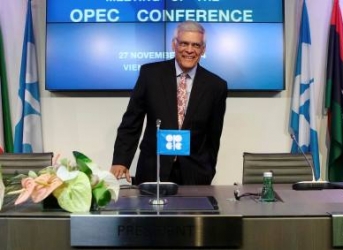Oil price update and North-American rig count
(Click to enlarge)
Chart of the Week

• More than 2,000 megawatts of nuclear capacity scheduled for retirement by 2019
o Closures: Entergy’s Pilgrim Nuclear Power Station (2019); Exelon’s Oyster Creek (2019)
• More than 5,000 megawatts of nuclear capacity to come online between 2016 and 2020
o New reactors: Watts Bar Unit 2 (TN); Vogtle (GA); V.C. Summer (SC) Related: U.S. Production Finally Starting To Drop Significantly
Market Movers
• Chevron (NYSE: CVX) announced first oil production from the Lianzi project off the coast of Congo-Brazzaville and Angola. Production is expected to reach 40,000 barrels of oil equivalent per day. Lianzi is the first cross-border oil project in central Africa.
• Noble Energy (NYSE: NBL) has announced that it would not make a final investment decision on its large gas discoveries in the Eastern Mediterranean until 2016. The Tamar and Leviathan gas discoveries are massive, but development has been held up by regulatory uncertainty from the Israeli government. Noble’s announcement comes just one day after the Israeli government promised to fast-track the projects.
• Royal Dutch Shell (NYSE: RDS.A) announced that it sold its France-based Butagaz liquefied petroleum gas asset to DCC Energy for $513 million. Shell also sold its 75 percent stake in the Tongyi Lubricants in China for an undisclosed sum. The moves are part of Shell’s campaign to sell off assets to raise cash.
Tuesday November 3, 2015
Shell provided an update on its pending merger with BG Group (LON: BG). Following its dreadful quarterly earnings report, Shell provided another defense of its BG purchase, which it says will provide greater savings than previously expected. The tie up will be profitable even if oil prices range in the mid $60s per barrel, Shell argues. It will also create two separate entities – one for natural gas, and another for oil sands and shale. Shell obviously sees natural gas as a central part of its future, and that was a major motivation behind the purchase of BG. But some shareholders are skeptical, arguing that the $70 billion sale price was too high. Shell’s CEO Ben van Beurden is eyeing the long game. “We are laying a platform for a fundamentally better company for the future in any oil price environment,” he said on November 3. Related: Oil Market Stalemate To Persist Until End Of 2016?
TransCanada (NYSE: TRP) reported a 12 percent decline in profits for the third quarter, compared to the same period in 2014. The Canadian pipeline company also asked the U.S. government to suspend its application for the Keystone XL pipeline, hoping that an incoming president in 2017 may offer a more favorable climate for the controversial project. TransCanada appears to be nervous that the Obama administration is set to shoot down the application and instead of trying to push it through, which it has done for the better part of a decade, TransCanada is shifting tactics and wants to put the process on ice until the next administration.
The Alaskan government may reconsider the current tax breaks that it offers to the oil industry as the state deals with shrinking revenues following the collapse in crude prices. The Wall Street Journal reports that the state gives over $1 billion in tax breaks to oil companies each year. That could negatively impact companies like ConocoPhillips (NYSE: COP), ExxonMobil (NYSE: XOM), and BP (NYSE: BP). WSJ estimates that the tax breaks often cover around 85 percent of the cost of drilling a well in Alaska. “We can no longer subsidize exploration,” Alaska Governor Bill Walker said. Saving on the tax credits would be good for the state, but it could also deter investment, ultimately negating the benefit of scrapping the incentives.
OPEC members are fighting over long-term strategy, with many countries far apart on how best to coordinate oil production. According to an internal strategy document, and reported on by Reuters, OPEC members Iran, Algeria, Iraq, and others put forward a variety of strategies, including a return to the quota system, production cuts, and a price target. Iran wanted a return to country-specific limits on production, which was backed by Algeria. Iraq wanted more autonomy for countries to set their own policies. But, despite all of the suggestions, Saudi Arabia maintains that the market should determine oil prices. The internal squabbles suggest that the December 4 meeting in Vienna will likely be contentious, with expectations of no change in policy. Related: Elon Musk’s Hyperloop Takes a Step Forward
Saudi Arabia holds enough sway to ensure OPEC stays the course, but it is also feeling the pain from the market share strategy. S&P downgraded Saudi Arabia’s credit rating last week to A+, arguing that oil prices are causing a widening budget deficit. The IMF expects Saudi Arabia’s deficit to reach 20 percent of GDP this year, and Bank of America Merrill Lynch said this week that the country was at risk of further credit downgrades if oil prices do not rebound.
The cutback in production from the Bakken has led refineries on the East Coast to turn to imported oil from abroad. Oil from Latin America, the Middle East, and Africa has become cheaper than North Dakota crude. Several refining companies, including PBF Energy (NYSE: PBF), are set to purchase the least amount of Bakken crude since 2013.
Statoil (NYSE: STO) has decided to build the world’s first and largest floating wind farm off the coast of Scotland. The 30 megawatt project will provide enough electricity for 20,000 homes and should be up and running by late 2017.
By Evan Kelly of Oilprice.com:
- OPEC Members Pushing For Quotas Or A Price Floor
- This Nation Is Reviving Some Of The World's Biggest Copper Deposits
- Oil Megaprojects Won’t Stay On The Shelf For Long



















